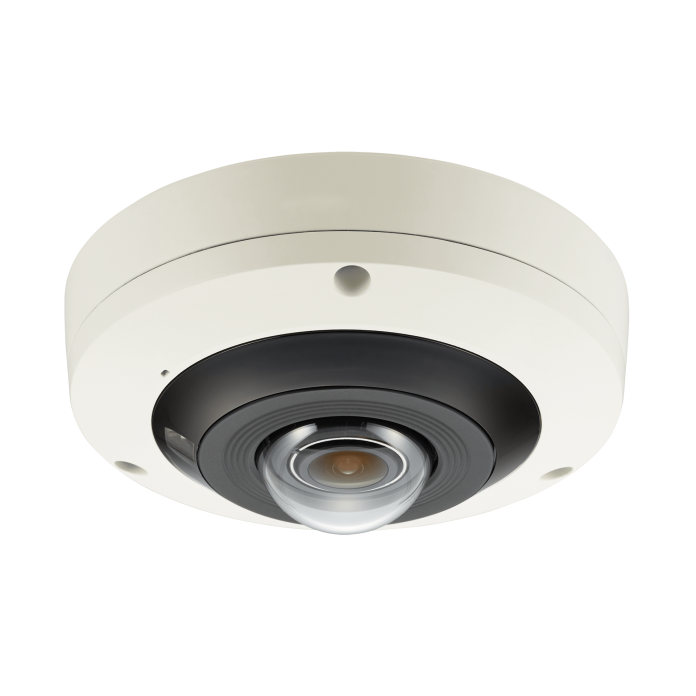Of all surveillance parameters, none is so riven by internal contradiction as the concurrent demand for wide angles of view and sufficient resolutions to deliver useful depths of field.
THERE’S no decision that pains a security manager quite so much as trying to decide which aspect of image quality is more important from the operational perspective of a security team – angle of view or depth of field. A Holy Grail of surveillance solutions is the ability to provide both these requirements at the same time with simultaneous recording.
The need for situational awareness and high levels of detail is baked into the very nature of powerful PTZ cameras, is an important characteristic of motorised bullet cameras and is the reason for being of many systems that tackle open spaces with a 3-decked broadside of fixed lens full body cameras, bullets and domes. The same imperatives drive the development of big pixel panomorphic cameras, which employ muscular software algorithms to untangle their never-ending barrel distortions.
If any single solution has touched the Grail, it’s Dallmeier’s Panomera, but not every application needs an engineered solution of such high quality. The secret for installers and end users is trying to find a camera or a solution that delivers the best balance of detail and angle of view while providing an image that is navigable at a cost that is affordable.
According to Andrew Cho at EOS the main attraction of the hemispheric camera or very wide-angle camera is the amount of the visibility from a single camera, but he agrees there are challenges.
“Pixel spread with a single wide lens is one of the biggest challenges,” Cho says. “But getting the end-users to understand the environmental requirement for the hemispheric camera is another challenge. The limitation of the installation height and the expectation of picture quality at certain distance needs to be addressed properly, too.
Cho argues a strength of hemispheric cameras lie in their ability to provide useful marketing analysis results.
“For example, fixed cameras are limited in terms of vision when it comes to analysing the movement within a store, while hemispheric cameras can cover much large areas and analyse movements to provide useful information.”
A key aspect of managing wide angle and hemispheric views is the ability to display and manipulate the image stream in multi-screens. Getting this right is vital.
“The manipulation of the image stream in multi-screen is the de-warping function,” Cho explains. “Raw video streams from a hemispheric camera can be very difficult to monitor as it is providing a fish-eye type view – products like WISENET provide on-board dewarping feature to manipulate the video stream into easier form to monitor such as quad split, panoramic view or a controllable digital PTZ view.”
For Cho, the perfect application for hemispheric cameras is ceiling mounted applications.
“I would recommend panomorphic hemispheric cameras in situations where the primary monitoring requires a birds-eye view from the ceiling,” he explains. “For example, monitoring the aisle in a supermarket from the ceiling. Multi-sensor cameras are best in situations where end-users require a wide horizontal monitoring application with a good depth of field, such as stadiums or street surveillance.”
Resolution is a key aspect of wide angle cameras and Cho argues 8MP or 4K is the ideal choice for larger applications, or 4-5MP for smaller spaces. He says multi-head camera will become more popular, given they can provide larger coverage with simpler installation. Cho agrees hemispheric and multi-head cameras do provide end-users with more and better choices.
“Importantly though, there must be a proper assessment of the environment as sometimes such a solution could be over-engineered and end up costing more money without any additional benefit compare to a normal fixed lens camera,” he explains.

Over at Hikvision, Danial Huang says that to a degree, the attraction of hemispheric cameras and very wide-angle cameras is their ability to offer complete situational awareness from a single camera point. But he says there are limits to the camera’s true performance based on its technical characteristics.
“Low profile hemispheric cameras use a single lens which captures everything in view,” Huang explains. “The lens is termed a ‘fisheye’, which means the picture is distorted and yet all-compassing. The quality of the lens, and the resolution of the sensor, will determine the usefulness of the result when you zoom in on the image.
“Between the various manufacturers you will find varied results in the quality of the images when you zoom in. It is fairly well accepted now that the absolute minimum specification for a useful image in a smaller environment is 5MP. The VMS or NVR that the camera is connected to, will often offer a dewarping of the entire image. In other words, it will provide separate images (e.g. split into 4 separate quadrants), that have been corrected to deliver straight lines (as we would normally view a scene).
“Another version of the above camera type, and in a larger profile, is the multi-head. This is where a number of cameras are in one housing and the images are stitched together to provide a somewhat seamless image. This avoids everything going through one lens so the quality of the image tends to be a little better. Some of these are even married with a PTZ suspended in the middle to provide the ability to zoom in on activity whilst still viewing/recording everything in the scene.”

According to Huang, the real strength of the hemispheric cameras is that they are low profile on the ceiling and are more aesthetic than traditional cameras.
“Architects often like security to be non-obtrusive in the environment as it can send the wrong message,” he explains. “With a hemispheric camera, there is only one camera to install, one cable to run and one POE port used.”
Huang says management of wide angle and hemispheric views is vital for video management solutions.
“This capability is a must have now and operators rely on this to provide useful video,” he says. “The ability to digitally pan, tilt and zoom the image stream in multi-screens allows flexibility when reviewing critical footage.
“We are seeing these cameras deployed over retail counters, self-serve areas, multi-bay loading docks, underground car parks and the like. The cameras only need 1 cable yet cover large areas in their entirety, so there is an efficiency/cost saving in the installation. Panoramic cameras are very useful in outdoor car parks when mounted on the external wall of a building. This often negates the need to put cameras out on poles throughout a carpark.”
When it comes to resolution, Huang says in offices, small retail areas, or small loading docks, 5MP is sufficient resolutions, but Hikvision recommends is 12MP cameras as a minimum standard for bigger spaces.
“In large warehouses we recommend mounting the camera on a pendant bracket, so as to get closer to the area of activity.”
Multi-head cameras that deliver Full HD resolution through say, four 90-degree camera lenses are particularly strong in some street applications where they offer reasonable depth of field – including faces towards 20m – and always-on recording through a full 360-degree field of view. Huang believes such cameras will become more common in street surveillance applications.
“We don’t want to rely on operators and PTZs due to human fatigue or error, or they might be looking at one incident while another incident is occurring outside their field of view,” he explains. “Multi-head cameras resolve such issues.
“Hemispherics and multi-head cameras are a key part of aspect of many surveillance solutions, especially considering the price for such cameras has also reduced dramatically. The development in compression technology (now H.265) also allows higher megapixel cameras to operate more efficiently without sacrificing too much storage.”

At Axis, Oshana Jouna says that while hemispheric cameras provide a wide field of view with greater coverage resulting in low camera count for a given site lowering the overall cost of a given installation, it’s also important to highlight that for the most part hemispheric cameras are primarily used for ‘situational awareness’ meaning that should more precise detail be required, it should be used in conjunction with other cameras placed at key points.
“Some of the design considerations when using hemispheric cameras include:
Pixel density: It’s less of an issue as higher resolution cameras become available, but we can still see soft edges even on higher resolution cameras due to the optical distortion of a lens where more detail is contained in the centre of the image and gradually reduces as you move towards the edge. This becomes more obvious when you digitally zoom into a specific area of the image.
Camera mounting height: To get a complete view of an object standing on the edge of the scene, the camera needs to be mounted high enough to view it. Is some indoor applications the mounting height could be a limiting factor.
Overview image Difficult to analyse: Real-time image processing technology helps to dewarp the spherical image and can also offer multiple views in real-time but the dewarping drivers are not available with every VMS.
Image only suitable for general overview: This is a trade-off between pixel density and angle of view. As the object is closer to the centre of the camera where the pixel density is highest the angle of view is not suitable for facial recognition/identifications. However, as we move away from the centre the angle is suitable but there are not enough pixels to achieve facial recognition/identification quality. Therefore, the hemispheric camera is only suitable for general overview and if facial recognition/identification is required another camera should be used.
Multi-head/multi sensor camera are processor intensive: Multi head cameras usually address the pixel density issue but this requires more processing power if a stitched image is needed. The stitching can be achieved at the camera side or the server side, in both cases more processing power is required. If a stitched image is not required multi-head cameras are a good alternative to hemispheric cameras.”
According to Jouna, strengths of hemispheric cameras include lower cost as a single camera can be used to achieve a wider coverage.
“They are also easier to install,” he explains. “If we are using single lens hemispheric camera or multi-head camera we only need to run one cable. To provide the same coverage with narrow angle cameras for the same coverage more cameras are required therefore more network cables and more installation locations. It’s also easier to review footage from only one camera with no blind spots after an event or crime has occurred.
“With dewarping, the overview image can be saved and dewarping can be achieved on the recorded footage and the live view. This feature is supported on most of the major VMSs. Also, as we have less cameras in the system, the maintenance process will be easier.”
According to Jouna, the perfect applications for panomorphic cameras include warehouses with a large open area with high ceiling, large building lobbies, gyms and carparks.
“Applications where multi-sensor camera are preferred over panomorphic include the intersections of hallways, aisles and roads, and at the corners of buildings, city surveillance at intersections, parking lots where the sensors need to be focused on certain areas, where corridor format can be used to capture vertically oriented scenes in 4 different directions and in the lobbies of schools, hotels and offices – I’d say 8 Megapixels is a good compromise between image quality/pixel density and bandwidth/storage requirements.”
Jouna says multi-head cameras are gaining in popularity for city surveillance, especially at major intersections.
“Most of the multi-head cameras are flexible in terms of lens selections – for instance, you can have different lenses with different fields of view installed on one camera,” he says. “An example is having one of the sensors installed with wide angle lens looking at a wide area, while the other sensors are equipped with narrower angle lenses focusing on narrow streets and therefore achieving longer range/higher pixel density. The other factor that makes the multi-sensor camera popular for street surveillance is the ease of installation, you can have 4 cameras (4 sensors) using a single POE connectivity. And the licensing cost for the VMS is also lower in multi-sensor camera. Effectively 4 cameras are installed at the price of 1.”

Phil Viggiano of CRK says a key issue with these camera types is managing customer’s understanding of how the cameras should be used, and the performance expectations – such solutions do not suit every camera application, he argues.
“When hemispheric or ultra wide-angle cameras are used correctly, they provide excellent situational awareness,” Viggiano explains. “However, they do have performance limitations when compared to traditional single sensor cameras. Dynamic range, low light performance, and infrared illumination distances are generally limited compared with more conventional cameras.
“In terms of strengths, once customers become accustomed to the user interface, they generally find it easier to understand and operate. Nor do integrators do not have to second guess exactly where each camera needs to be positioned and which are the areas of interest – the cameras is seeing everything. At the core of this is managing the video interface. Dallmeier has spent more than 7 years perfecting its Panomera user interface (SMAVIA Viewing Client).”
According to Viggiano, large geographic areas are best suited to multi sensor cameras.
“The most obvious examples are airports, stadiums, railway yards, city streets and other big spaces,” he explains. “No single design would be able to handle such very different deployments, which is why there are so many different versions of Panomera – low light, wide angle, 4K, etc.”
When it comes to best resolution, Viggiano says in the past high resolution meant high streaming rates and poor low light performance.
“By comparison, the latest Generation 12MP fisheye 360-degree camera from Uniview supports H265, has extremely good low light performance, and supports infrared up to 10 metres,” he explains. “IP67 and IK10 ratings mean it can be used in outdoor and harsh conditions, making it a jack of all trades.
“Multisensor cameras are well suited to very large applications where depth of field must be combined with wide angle of view. The new Dallmeier Panomera W8 is already being used in these environments all over the world, in particular with safe city projects and airports.”

Brendan White of MOBOTIX says hemispheric camera technology was initially designed to mitigate the cost of placing multiple cameras within an area to guarantee a holistic field of view.
“This minimised the number of required cameras, while also lowering operational costs but despite the attraction of hemispherics and wide angles, there are some challenges, depending on the camera system,” he explains. “For instance, pixel spread with single lens hemispherics, stitching with multi-head wide angle cameras – in my opinion, hemispheric cameras should only ever be used for overviews, with identification of persons within 3 metres. Clarity of objects past this point may suffer from lens distortion and pixel spread.
“The main strengths of hemispheric cameras is their ability to cover large areas from a single point, providing great situational awareness of sites, which is paramount when constructing an accurate series of events,” he says.
“Meanwhile, multi-sensor cameras are most suitable for sites that require wide-angle coverage but are still looking to maintain a certain level of pixels on target, effectively making use of ‘4 cameras in one’ saving on the physical installation and labour of actually installing four individual cameras.”

According to White, the quality of dewarping varies by camera manufacturer.
“Most end-users are not familiar with the ‘fisheye’ view,” White says. “This makes it important for hemispheric cameras to be able to offer efficient dewarping in a decentralised environment when cameras are installed as standalone. Equally, it should also be possible to offload this distortion correction onto a software VMS platform to enhance the dewarping process via hardware acceleration.”
White argues that for the current iteration of hardware available in early 2018, 6MP Resolution is the sweet spot for hemispheric camera quality, as the wider end-user market is not using 4K monitors.
“Also, bearing in mind that hemispheric cameras are mostly used as overview cameras providing coverage for larger areas, this resolution is often more than adequate for the purpose,” he says. “Taken as a whole, hemispheric camera technology allows for efficient overviews of wide areas while contributing to the holistic operation of a CCTV system, allowing a user to construct an accurate series of events. Requiring few cameras in turn decreases the initial installation costs and provides year-on-year savings with regards to power consumption.”
By John Adams










